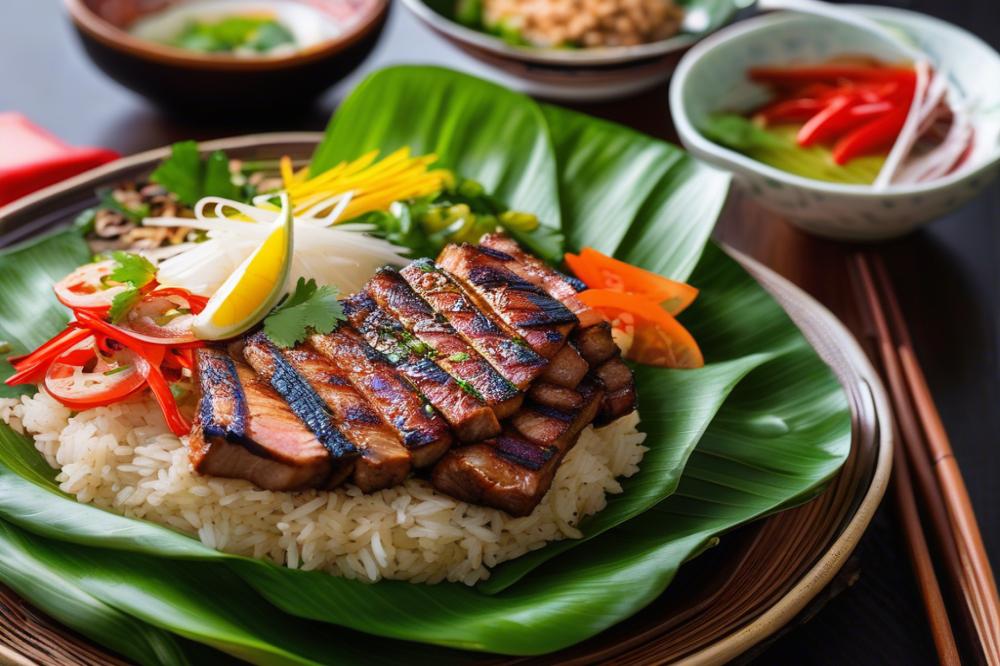Introduction
Vietnamese cuisine is renowned for its rich diversity. Flavors burst with fresh herbs, spices, and ingredients from land and sea. Special emphasis lies on rice as a staple food. Dishes vary significantly across regions, reflecting local cultures and traditions. From savory soups to flavorful rice recipes, every meal tells a story.
Among these culinary treasures is a classic dish known as Cơm Tấm. This traditional meal features broken rice, which is often overlooked but holds a special place in Vietnamese culture. Originally, broken rice was considered a less desirable product, but it has transformed into a beloved staple. Often served with a variety of toppings, it stands out as a delicious and comforting choice.
Particularly in South Vietnam, Cơm Tấm has become a cornerstone of food culture. Street food vendors serve it to eager customers seeking quick and satisfying meals. Marinated pork, grilled to perfection, often accompanies this dish, creating a delightful harmony of textures and flavors. The sizzling sound of meat on the grill adds to the tantalizing experience. Each bite reveals the love and care that goes into preparing such delightful meals.
Because of its popularity, Cơm Tấm is not just a dish; it’s a symbol of community and culture. Families gather around tables, enjoying this simple yet flavorful meal. The atmosphere of street food stalls, filled with laughter and conversation, reflects the heart of South Vietnamese life. Indeed, these elements combine to make Cơm Tấm an unforgettable culinary experience.
Cơm Tấm: An Insight into Broken Rice
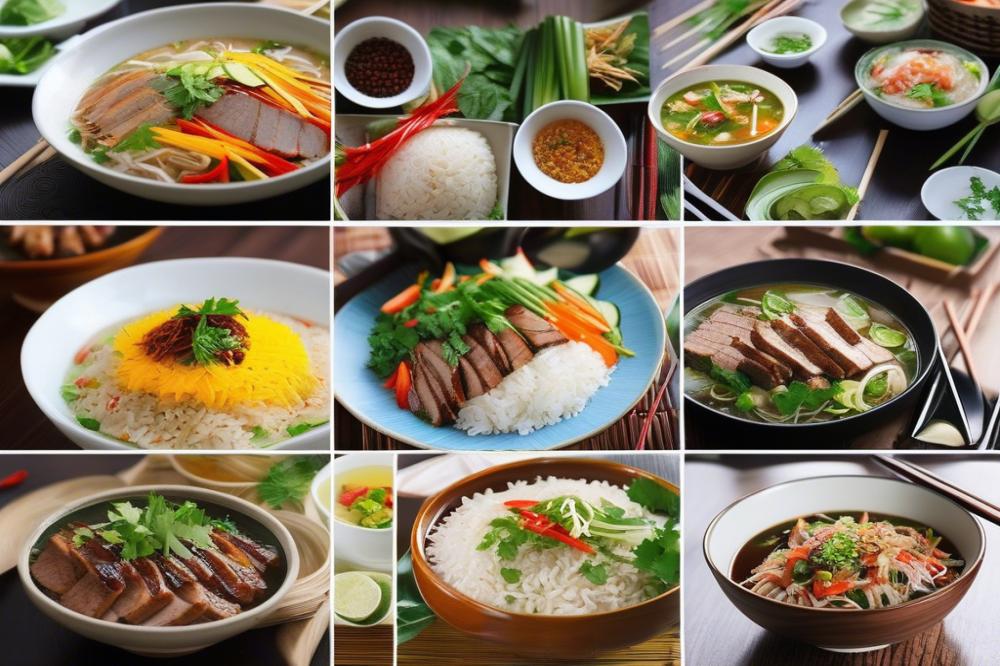
Broken rice refers to rice grains that have been damaged during the milling process. Though these grains may not look perfect, they have a rich history in Vietnamese cuisine. In the past, broken rice was considered a poor man’s food, primarily because it was cheaper than whole grains. Farmers and workers relied on this type of rice, making it a staple in South Vietnam.
Cơm Tấm holds a significant place in the culture of Vietnam. It symbolizes resilience and resourcefulness. Over the years, this dish has evolved into a beloved street food favorite enjoyed by people from all walks of life. Vendors often serve it with Grilled Pork that has been marinated in a blend of spices, adding flavor to an already delightful meal. For many, it is not just food; it embodies a sense of community and family.
This traditional dish stands out among the countless rice recipes found in Vietnamese food culture. Unlike plain white rice, broken rice offers a different texture and taste. Cơm Tấm is often served with various toppings, such as fried eggs, pickled vegetables, and grilled meats, which create a perfect harmony of flavors. Meals crafted with broken rice tend to be more satisfying, capturing the essence of Vietnamese street food.
Ingredients and Cooking Instructions
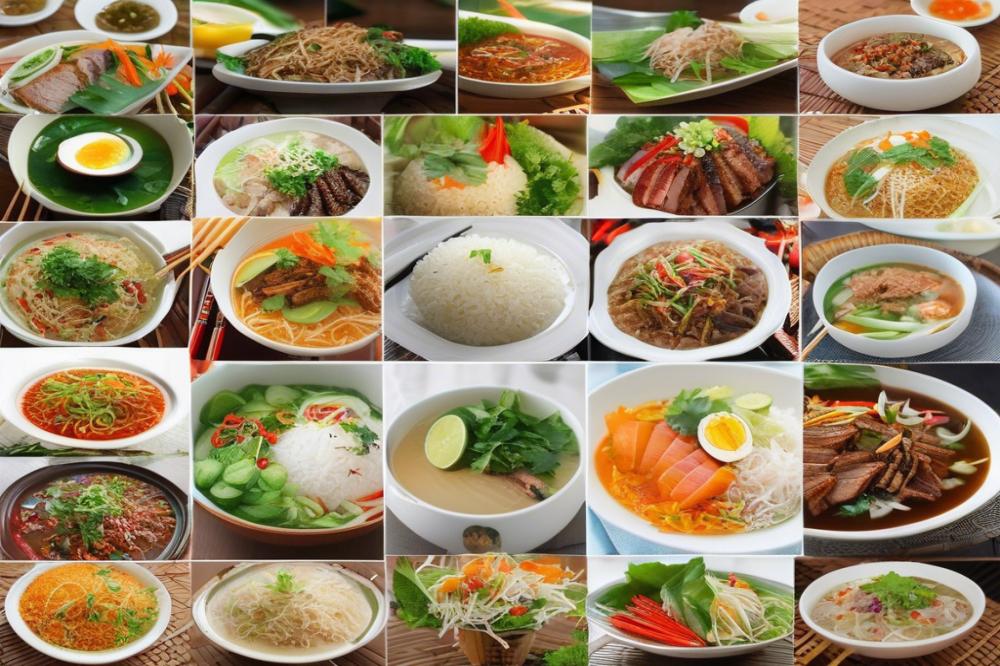
Detailed Ingredient List with Quantities
- Broken rice: 2 cups
- Pork shoulder: 500g
- Fish sauce: 4 tablespoons
- Sugar: 1 tablespoon
- Garlic: 3 cloves, minced
- Black pepper: 1 teaspoon
- Soy sauce: 2 tablespoons
- Vegetable oil: 2 tablespoons
- Pickled vegetables for serving (carrots and daikon radish)
Cooking Instructions
Step by Step Preparation of Marinated Pork
Start by slicing the pork shoulder into thin pieces. Mix garlic, fish sauce, sugar, soy sauce, and black pepper in a bowl. Add the pork to the bowl and coat well. Let it marinate for at least one hour. For deeper flavors, consider marinating overnight in the fridge. This allows the spices to infuse beautifully.
Grilling the Pork
Prepare the grill or stovetop grill pan. Heat it to medium-high. Brush the grill with vegetable oil to prevent sticking. Place the marinated pork pieces on the grill. Cook each side for about 4-5 minutes until they are nicely charred and cooked through. The aroma will fill the air, showcasing the essence of Vietnamese street food.
Preparing Broken Rice
Rinse the broken rice under cold water until the water runs clear. This helps remove excess starch. Combine washed rice with 4 cups of water in a pot. Bring to a boil, then lower the heat to a simmer. Cover the pot and cook for approximately 20 minutes. Fluff the rice with a fork when done. Broken rice is essential for this traditional dish.
Serving Suggestions and Presentation Tips
To serve, place a generous helping of broken rice on a plate. Arrange the Grilled Pork on top. Garnish with pickled carrots and daikon radish on the side. Drizzling extra fish sauce over the pork can enhance the flavors. For a finishing touch, freshly chopped cilantro can be sprinkled on top for added color and freshness.
Nutritional Information
Each serving of this delightful meal provides around 500 calories. It typically contains about 30 grams of protein, 20 grams of fat, and 60 grams of carbohydrates. This dish is not only delicious but also fulfills nutritional needs, making it a great option in Vietnamese cuisine.
The Art of Marinating and Grilling Pork
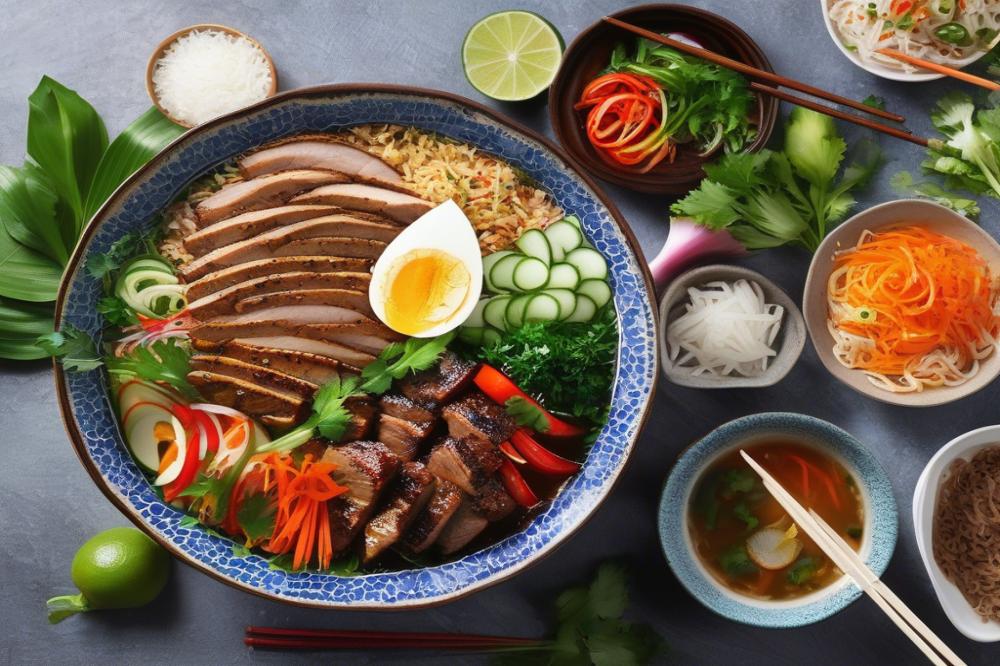
In Vietnamese cuisine, marinating pork is an essential step in creating flavorful dishes. Families often have their own recipes passed down through generations. Ingredients like fish sauce, garlic, and freshly ground pepper play significant roles in the marinade. Fish sauce brings umami, while garlic adds warmth and depth. Pepper offers a touch of heat that makes every bite exciting.
Marinating the pork is not just about taste; it’s about the experience. The meat should soak up the flavors for several hours, or even overnight. This time allows the ingredients to blend, creating a delicious outcome. Many cooks insist that the longer the pork marinates, the more tender and flavorful it becomes. For street food vendors in South Vietnam, this process can make or break a dish.
Grilling Techniques
Grilling methods can differ, which impacts the dish’s final flavor. Charcoal grilling is popular, especially for its smoky aroma. Using charcoal adds a unique depth to the meat. Many people believe this method brings the best out of marinated pork. The connection between the smoke and the marinade creates a memorable taste that street food lovers crave.
Gas grilling, on the other hand, offers convenience and quick cooking times. While it may lack the complexity of charcoal, many enjoy its ease. The control over temperature is another advantage, especially for beginner cooks. Both methods can produce delicious meals, so it often comes down to personal preference.
Ultimately, the art of marinating and grilling pork is about understanding flavors and techniques. Learning these skills is vital for anyone interested in making authentic rice recipes. Whether enjoying broken rice at a local eatery or preparing it at home, the preparation is as important as the final presentation.
Serving Cơm Tấm: A Full Experience
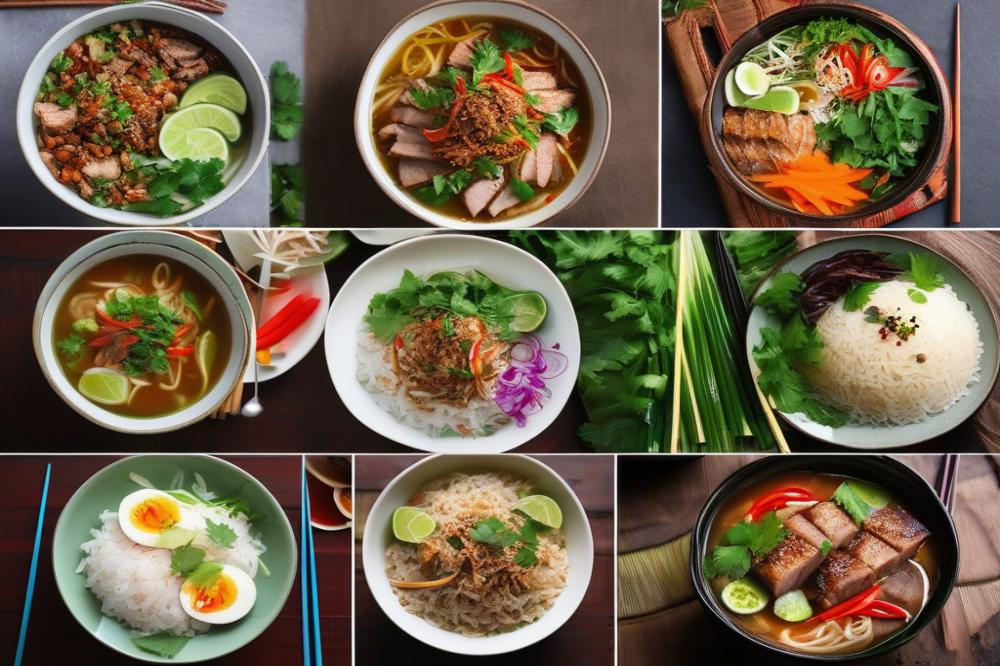
In Vietnamese cuisine, the joy of enjoying broken rice comes from its various accompaniments. Pickled vegetables are a must-have. They add a crunchy texture and a tangy flavor that complements the marinated pork beautifully. Fried eggs also play a role in elevating the dish. Their creamy yolks provide a rich contrast to the savory elements. Another popular topping is shredded pork skin, known as “bì.” This adds a delightful crunch to each bite.
Presentation matters greatly when serving this traditional dish. Typically, it comes arranged on a platter, showcasing the different components. The dish is served on a bed of fluffy, broken rice. Grilled pork is placed on top, allowing its smoky aroma to waft through the air. The colors of the side items create a feast for the eyes. Imagine the golden egg, vibrant pickled carrots, and the green of fresh herbs against the white rice.
Popular Variants of Cơm Tấm Across Vietnam
While the classic version remains beloved, you can find many variants across South Vietnam. Some places offer a seafood twist with shrimp or fish. Others might surprise you with a ginger-flavored pork. Street food vendors often enhance the dish with a spicy sauce for those who like heat. Each region tends to adapt the recipe to its local flavors. These rice recipes not only show diverse tastes but also celebrate the rich food culture of Vietnam.
Cơm Tấm in Modern Vietnamese Food Culture
Evolution of Cơm Tấm in Contemporary Cuisine
Traditionally, broken rice comes from South Vietnam. This type of rice was once considered a humble choice. However, the dish has transformed over time. It now represents a staple in modern Vietnamese cuisine. Chefs experiment with various ingredients, pushing the boundaries of this beloved meal. Inspired by global trends, many restaurants elevate its presentation. Along with grilled meats, you may find fresh vegetables and flavorful sauces. Today, Cơm Tấm appeals to a wider audience, attracting food lovers everywhere.
Popularity in Restaurants and Street Food Stalls
Street food offers a unique charm for enjoying this dish. Vendors serve it hot with grilled pork, often marinated in special spices. Many people flock to these stalls, eager to taste this delicious meal. On the other hand, upscale restaurants also embrace this traditional dish. They offer beautifully plated versions, making it a culinary experience. Diners appreciate both the authentic flavor and the creativity involved. Whether in a bustling market or a fine dining setting, Cơm Tấm is always a hit.
Influence on Global Vietnamese Food Scene
This dish has reached beyond Vietnam’s borders. Various rice recipes inspired by Cơm Tấm are popping up in kitchens worldwide. As more people learn about Vietnamese cuisine, interest grows. Many food enthusiasts want to recreate the rich flavors at home. Grilling marinated pork has become popular in international barbecues. With presentations varying from casual to gourmet, Cơm Tấm captures hearts everywhere. It has firmly established its place in the global food culture, reflecting the essence of Vietnamese dining.
A Culinary Tradition Worth Exploring
Broken rice is more than just a dish; it embodies a rich part of Vietnamese cuisine. Sharing a plate of grilled pork over this flavorful base is a delightful experience. Families often gather around tables to enjoy this meal, passing down recipes and stories along the way. Preparing this dish at home can be a rewarding adventure. It invites you to experiment with flavors and cooking techniques. Confidence in the kitchen can grow with each attempt.
Trying to recreate this popular dish offers a deeper connection to its cultural roots. As each ingredient blends together, flavors unfold in delightful ways. While genuine textures may be found in a restaurant, a homemade version brings a special warmth. Think of the aromas and the satisfaction of sharing your creation with loved ones. Simple steps lead to a delicious result, even for beginners.
Food plays a significant role in preserving traditions. Traditional meals connect generations, reminding us of who we are and where we come from. They reveal stories of history, culture, and family values. The significance cannot be underestimated. Every bite offers a glimpse into the heart of a vibrant culture. Enjoying Cơm Tấm is one way to celebrate and honor these relationships.

